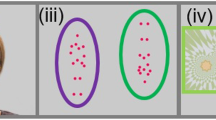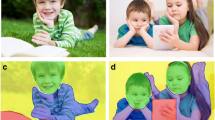Abstract
Longitudinal videotape recordings of six young children with autism and six age- and language-matched children with Down syndrome in structured play with their mothers at home were coded for the focus of the child's visual attention for four bimonthly visits and for facial affect for two of the four visits. The main finding was that the children with autism showed reduced expression of positive affect in a familiar social context. The autistic group attended to the mother's face and the researchers only about half as much as the Down syndrome group, but these differences did not reach statistical significance. Compared to the Down syndrome group, the autistic group displayed a smaller proportion of their total positive affect toward the mother's face and toward the researcher, but only the latter group difference reached statistical significance. Although limited by the small sample size, these findings suggest that autistic children's known deficits in attention and affective responsiveness to others persist even in structured interactions with a familiar partner in the home.
Similar content being viewed by others
REFERENCES
Adamson, L., & Bakeman, R. (1985). Affect and attention: Infants observed with mothers and peers. Child Development, 56, 582–593.
American Psychiatric Association. (1987). Diagnostic and statistical manual of mental disorders (3rd ed., rev.). Washington, DC: Author.
Arcus, D., Snidman, N., Campbell, P., Brandzel, S., & Zambrano, I. (1991, March). A program for coding behavior directly from VCR to computer. Biennial Conference of the Society for Research in Child Development, Seattle, WA.
Bakeman, R., & Adamson, I. (1984). Coordinating attention to people and objects in mother-infant and peer-infant interaction. Child Development, 55, 1278–1289.
Berger, J., & Cunningham, C. (1981). The development of eye contact between mothers and normal versus Down's syndrome infants. Developmental Psychology, 17, 678–689.
Bloom, L., Beckwith, R., Capatides, J., & Hafitz, J. (1988). Expression through affect and words in the transition from infancy to language. In P. Baltes, D. Featherman, & R. Lerner (Eds.), Life-span development and behavior. Hillsdale, NJ: Erlbaum.
Dawson, G., & Galpert, L. (1990). Mothers' use of imitative play for facilitating social responsiveness and toy play in young autistic children. Development and Psychopathology, 2, 151–162.
Dawson, G., Hill, D., Spencer, A., Galpert, L., & Watson, L. (1990). Affective exchanges between young autistic children and their mothers. Journal of Abnormal Child Psychology, 18, 335–345.
Feinman, S. (1982). Social referencing in infancy. Merrill-Palmer Quarterly, 28, 445–470.
Hutt, C., & Ounsted, C. (1966). The biological significance of gaze aversion with particular reference to the syndrome of infantile autism. Behavioral Science, 11, 346–356.
Kanner, L. (1943). Autistic disturbances of affective contact. Nervous Child, 2, 217–250.
Kasari, C., Mundy, P., Yirmiya, N., & Sigman, M. (1990). Affect and attention in children with Down syndrome. American Journal on Mental Retardation, 95, 55–67.
Kasari, C., Sigman, M., Mundy, P., & Yirmiya, N. (1990). Affective sharing in the context of joint attention interactions of normal, autistic, and mentally retarded children. Journal of Autism and Developmental Disorders, 20, 87–100.
Kasari, C., Sigman, M., & Yirmiya, N. (1993). Focused and social attention of autistic children in interactions with familiar and unfamiliar adults: A comparison of autistic, mentally retarded, and normal children. Development and Psychopathology, 5, 403–414.
Knapp, M. L. (1980). Essentials of nonverbal communication. New York: Holt, Rinehart and Winston.
Landry, S., & Chapieski, M. (1990). Joint attention of six-month-old Down syndrome and preterm infants: I, Attention to toys and mother. American Journal on Mental Retardation, 94, 488–498.
Leiter, R. (1974). International Performance Scale. In O. Buros (Ed.). Tests in print II: Index to tests, test reviews and the literature on specific tests. Highland Park, NJ: Gryphone.
Mirenda, P. L., Donnellan, A. M., & Yoder, D. E. (1983). Gaze behavior: A new look at an old problem. Journal of Autism and Developmental Disorders, 13, 397–409.
Mundy, M., Sigman, R, Ungerer, J., & Sherman, T. (1986). Defining the social deficits of autism: The contribution of non-verbal communication measures. Journal of Child Psychology and Psychiatry, 27, 657–669.
Richer, J., & Coss, R. (1976). Gaze aversion in autistic and normal children. Acta Psychiatrica Scandinavica, 53, 193–210.
Rutter, M. (1978). Diagnosis and definition. In M. Rutter & E. Schopler (Eds.), Autism: A reappraisal of concepts and treatment. New York: Plenum Press.
Sigman, M., Mundy, P., Sherman, T., & Ungerer, J. (1986). Social interactions of autistic, mentally retarded and normal children and their caregivers. Journal of Child Psychology and Psychiatry, 27, 647–655.
Snow, M., Hertzig, M., & Shapiro, T. (1987). Expression of emotion in young autistic children. Journal of the American Academy of Child and Adolescent Psychiatry, 26, 836–838.
Tager-Flusberg, H., Calkins, S., Nolin, T., Baumberger, T., Anderson, M., & Chadwick-Dias, A. (1990). A longitudinal study of language acquisition in autistic and Down syndrome children. Journal of Autism and Developmental Disorders, 20, 1–21.
Trad, P. V, Bernstein, D., Shapiro, T., & Hertzig, M. (1993). Assessing the relationship between affective responsivity and social interaction in children with pervasive developmental disorder. Journal of Autism and Developmental Disorders, 23, 361–377.
Tronick, E. (1989). Emotional communication in infants. American Psychologist, 44, 112–119.
Volkmar, F., Hoder, E., & Cohen, D. (1985). Compliance, negativism, and the effects of treatment structure in autism: A naturalistic, behavioral study. Journal of Child Psychology and Psychiatry, 26, 865–877.
Volkmar, F., & Mayes, L. (1990). Gaze behavior in autism. Development and Psychopathology, 2, 61–69.
Vygotsky, L. (1978). Mind in society: The development of higher psychological processes. Cambridge, MA: Harvard University Press.
Winer, B. (1978). Statistical principles in experimental design. New York: McGraw-Hill.
Wing, L. (1976). Diagnosis, clinical description, and prognosis. In L. Wing (Ed.), Early childhood autism. Oxford: Pergamon.
Author information
Authors and Affiliations
Rights and permissions
About this article
Cite this article
Joseph, R.M., Tager-Flusberg, H. An Investigation of Attention and Affect in Children with Autism and Down Syndrome. J Autism Dev Disord 27, 385–396 (1997). https://doi.org/10.1023/A:1025853321118
Issue Date:
DOI: https://doi.org/10.1023/A:1025853321118




